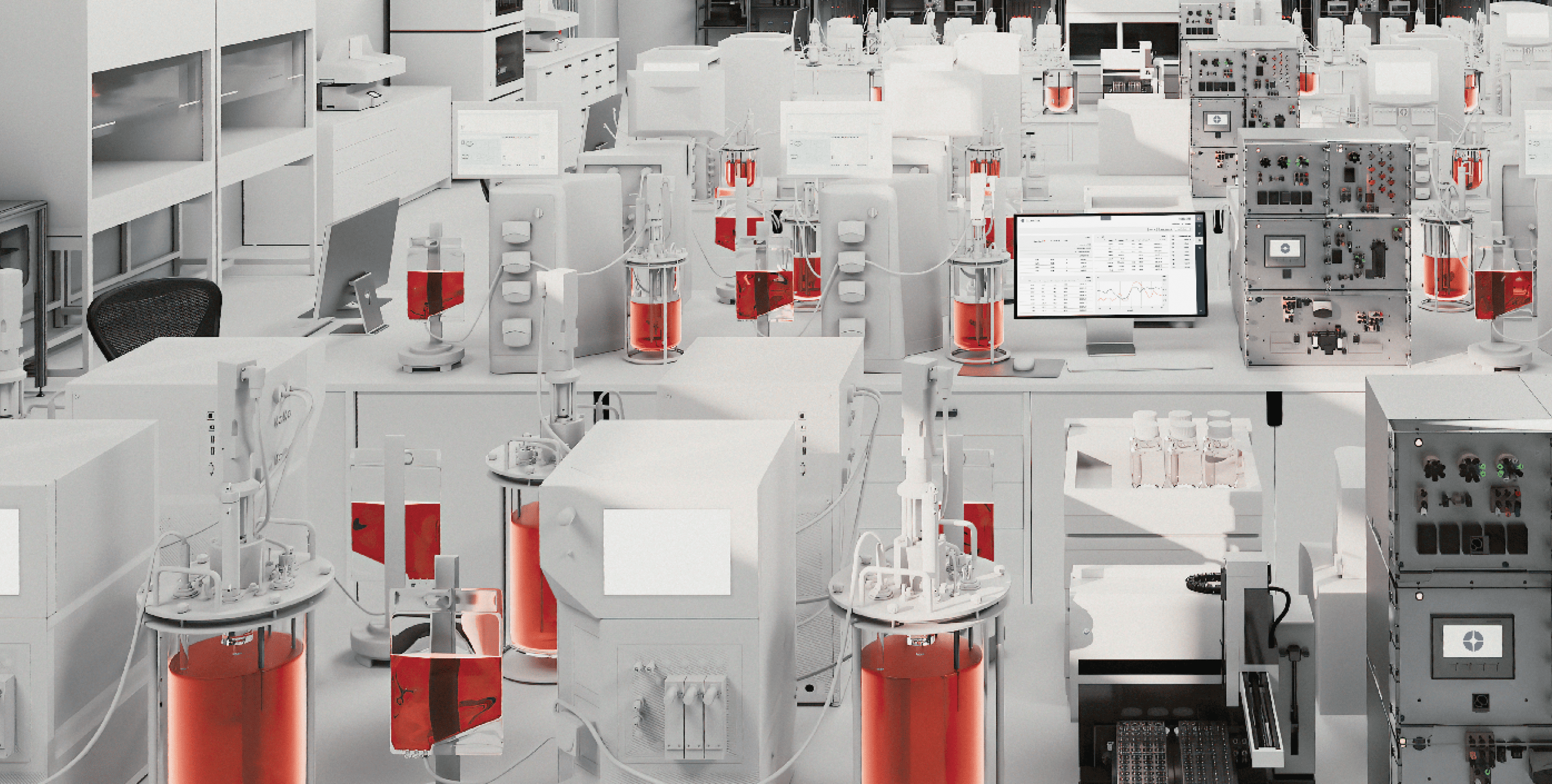Materials and Methods
The production of adenoviral vectors was conducted in three bioreactors (AdV01, AdV02, AdV03), and an additional bioreactor was used for pure cell growth (CG). The detailed operational parameters of the bioreactor can be found in Table 1. Samples for the off-line measurement of cell density and four metabolites (glucose, glutamine, lactate, and ammonium) were collected every 8 – 12 hours.

‡ Hours post infection (hpi); † Number of samples collected post infection in the bracket.
Abbreviations: MOI, multiplicity of infection; TOI, time of infection; VCD, viable cell density.
The bioreactors were controlled by an Applikon my-Control controller, with data logged by the Lucullus® software at 5-second intervals. Capacitance and conductivity were measured using a dielectric probe, with data streamed to Lucullus® at 1-minute intervals. The capacitance, conductivity, dissolved oxygen, cumulative oxygen, cumulative CO2, cumulative base, cumulative feed (glucose and glutamine), and pH data collected by Lucullus® were exported to MATLAB for further analysis..
Data Analysis Workflow
Figure 1 shows the data analysis workflow of this study. Data preprocessing involved zeroing capacitance based on pure medium readings and zeroing other parameters based on inoculation values. To correlate signals with off-line measurements, the cumulative data were aligned with off-line measurements, while other signals were averaged within a 2-hour time frame preceding each measurement. Two oxygen uptake rate indicators were derived from dissolved oxygen and cumulative oxygen, as per equations 1 & 2.

Partial least squares regression (PLS) and linear regression (LR) were used to correlate signals with off-line measurements. Batches CG, AdV01, and AdV03 were used as the training dataset, while batch AdV02 was used as the testing dataset due to the mild infection conditions. The number of components in PLS regression and LR hyperparameters was configured through 5-fold cross-validation within the training group. Models were trained with all mentioned process parameters or without capacitance and conductivity data, denoted as PV or PVDE, respectively. Targets measured off-line were used either directly or after subtracting their initial known value (denoted as PLS- and LR-). Cross-validation and prediction performance were compared using normalized root-mean-square errors (nRMSE). Details of signal analysis, data preprocessing, and model training can be found in the literature [2].

Result
For all target predictions, the models provided good performance during cross-validation, but the test performance on batch AdV02 varied, likely due to the distinct conditions of each batch. Including signals from the dielectric probe improved the performance (decreased nRMSEp), except for lactate. The best accuracy for each target was comparable to results achieved using advanced spectroscopic techniques, such as Raman or fluorescence probes, for in-line cell density and metabolite monitoring [3, 4].
For VCD prediction, all methods achieved low nRMSEcv values of around 6 – 8%, but nRMSEp was higher for models based on PV only (Figure 2a). The PVDE_PLS-model demonstrated the best prediction performance, accurately predicting VCD even after infection (Figure 2f), whereas capacitance readings calibrated based on pre-infection VCD values were higher than off-line cell counts.
For glucose monitoring, all models achieved nRMSEcv values less than 5.5%. The PVDE_LR model demonstrated the lowest nRMSEp (3%) (Figure 2b). The PVDE_LR- model achieved the best performance for glutamine monitoring, with nRMSEcv and nRMSEp values of 4.7% and 6.9%, respectively (Figure 2c). PV data alone were sufficient for lactate monitoring, with the PV-LR- model yielding an nRMSEp of 8.1%. Although incorporating DE information results in a very low nRMSEcv for lactate monitoring, the model appears to be overfitted, as indicated by a high nRMSEp. This may be due to the fact that AdV02 is a fed-batch run with three feeding events, whereas all training batches contain only a single feeding. As a result, the model fails to decouple the highly correlated parameters: cumulative base in PV, which is independent of feeding, and conductivity in DE, which is not. This limitation could be addressed by incorporating additional fed-batch datasets to improve model generalizability and parameter decoupling. For ammonium monitoring, all models showed similar performance, with nRMSEcv values between 7.5 – 10%. The PVDE_LR model achieved the lowest prediction error (nRMSEp = 9%).

Conclusion
This study demonstrates the ability to reliably monitor adenovirus production processes using basic process parameters with appropriate preprocessing, without the need for advanced spectroscopic equipment. Including signals from the dielectric probe further improved monitoring performance for most targets, except lactate. This work also demonstrated the value of the Lucullus® software for overarching process monitoring, centralized and harmonized data storage, and process control. Although MATLAB was used for data analysis, real-time data preprocessing and prediction are achievable through built-in Lucullus® functions or APIs.
Lucullus® Software
The Lucullus® Bioprocess Software is a comprehensive software solution for bioprocess data management. The software provides vendor-agnostic monitoring and control of diverse laboratory devices while enabling automation and digitalization of critical workflows. These include process planning, media preparation, process execution, sample management, and process evaluation. Equipped with state-of-the-art and customizable interfaces, Lucullus® seamlessly integrates into bioprocess environments, ensuring efficient data acquisition and exchange across instruments, software platforms, and databases. This integration minimizes data silos, prevents information loss, and significantly reduces the need for manual data handling, enhancing process reliability and efficiency.
References
- Petiot, E., et al., Influence of HEK293 metabolism on the production of viral vectors and vaccine. Vaccine, 2015. 33(44): p. 5974 – 5981.
- Xu, X., et al., Multivariate data analysis on multisensor measurement for inline process monitoring of adenovirus production in HEK293 cells. Biotechnology and Bioengineering, 2024. 121(7): p. 2175 – 2192.
- Oliveira Guardalini, L.G., et al., Biochemical monitoring throughout all stages of rabies virus-like particles production by Raman spectroscopy using global models. J Biotechnol, 2023. 363: p. 19 – 31.
- Classen, J., et al., A novel LED-based 2D-fluorescence spectroscopy system for in-line bioprocess monitoring of Chinese hamster ovary cell cultivations II. Eng Life Sci, 2019. 19(5): p. 341 – 351.










